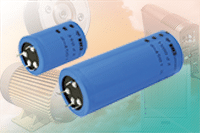source: Vishay news
MALVERN, Pa. — Feb. 15, 2017 — Vishay Intertechnology, Inc. (NYSE: VSH) today introduced a new series of 400 V and 450 V snap-in, four-terminal aluminum electrolytic capacitors with improved ripple current capability at an ambient temperature of 105°C in 15 large case sizes. Designed for power supplies and industrial and home appliance inverters, the Vishay BCcomponents 299 PHL-4TSI series reduces component counts and lowers costs, while increasing mechanical stability and end-product lifetimes.
Featuring a cylindrical aluminum case with pressure relief, insulated with a blue sleeve, the devices released today offer high ripple current from 2.45 A to 6.77 A, allowing designers to utilize fewer components to meet the requirements of applications connected to a three-phase mains. The 299 PHL-4TSI capacitors have a high 105 °C temperature capability and long useful life of 5000 h while still being able to withstand high ripple currents.
The capacitors can replace banks of large screw terminal devices connected by a bus-bar with smaller parts connected by a PCB. This significantly lowers construction costs and enables soldering processing instead of manual mounting. With larger case sizes than standard two-terminal snap-in capacitors — ranging from 35 mm by 50 mm to 45 mm by 100 mm — the devices limit the number of components required.
As polarized aluminum electrolytic capacitors with a non-solid electrolyte, 299 PHL-4TSI series devices are ideally suited for smoothing, filtering, and energy storage in pulsed power applications. The devices are RoHS-compliant; their four-terminal configuration provides increased mechanical stability and keyed polarity.
Samples and production quantities of the 299 PHL-4TSI series capacitors are available now, with lead times of 10 to 12 weeks.
Device Specification Table:
| Case size (D x L in mm) | 35 x 50 to 45 x 100 |
| Capacitance range | 470 µF to 2200 µF |
| Tolerance | ± 20 % |
| Ripple current at 100 Hz and +105 °C | 2.45 A to 6.77 A |
| Rated voltage | 400 V to 450 V |
| Category temperature range | -40 °C to +105 °C |
| Useful life at +105 °C | 5,000 h |
| Max. ESR at 100 Hz | 60 mΩ to 240 mΩ |
| Max. impedance at 10 kHz | 50 mΩ to 170 mΩ |
| Sectional specification | IEC 60384-4/EN130300 |
| Climatic category IEC 60038 | 40/105/56 |































